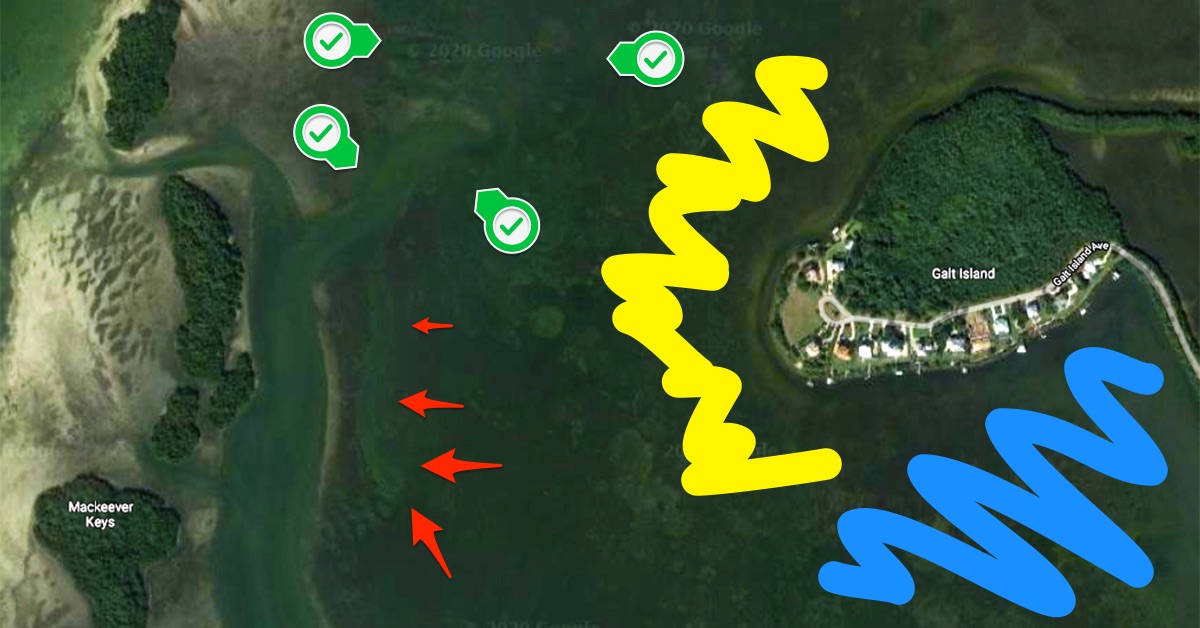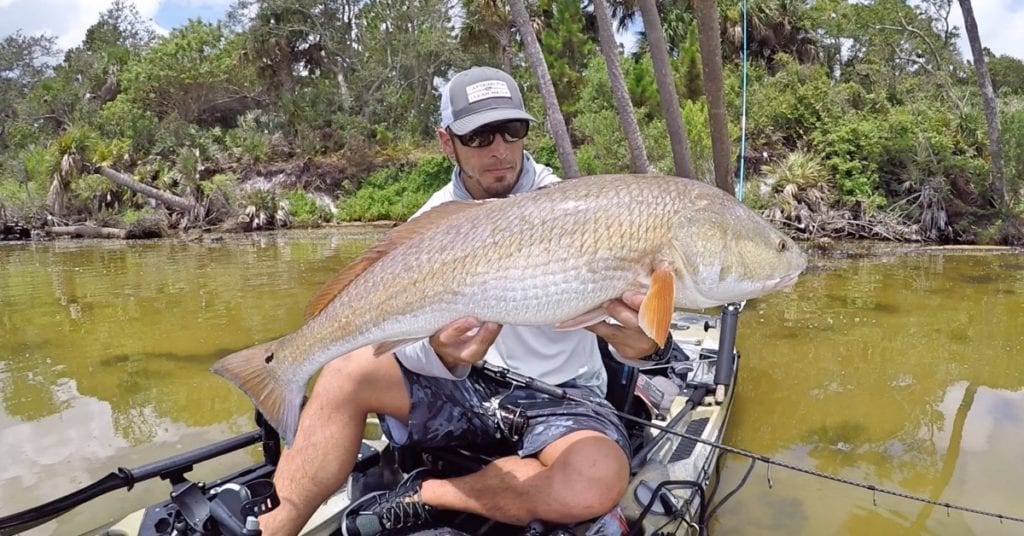How To Fish A Flat (For Redfish, Trout, Flounder & Snook)
- By: Tony Acevedo
- on

Note: This very popular post on how to fish a flat was originally published on December 7, 2020. But since then, we’ve had TONS of very helpful info added to the comments, so be sure to read the comments section too. Enjoy!
Everybody knows flats are great areas to find hungry fish…
But not everyone knows where to find fish on a flat.
Flats can be huge!
Where do you start?
Where are the fish?
How do you find a flat on an online map?
I’ll answer all of these questions and more in the video below.
Enjoy!
How To Fish A Flat [VIDEO]

What Makes A Good Flat
Good flats have seagrass on them.
They’re usually about four feet deep or less because grass needs sunlight, and any deeper than that makes it harder for grass to grow.
The more grass, the more bait, the more predator fish.
You can usually spot seagrass is on a map because it’s a dark, mottled color.
This is different than mud or sand, which is usually a uniform brown or tan.
Where To Find Fish On A Flat
Although you want to find flats with lots of grass on them, you don’t want to fish right in the middle of all that grass.
You want to fish the edges of the flats themselves, as well as edges of sandy potholes within a flat, and there are two reasons for that:
Reason #1: The edges of grassy areas provide ambush spots for predators to hide in or around and hunt baitfish that are out in the open.
In the thick grass, both predators and prey have lots of hiding spots, so you’ll have a harder time catching them there, unless you use a lure that swims above the grass, like a paddletail or topwater lure.
Reason #2: The edges of grass flats where there’s depth change are great for extreme temperatures.
In the winter, you can fish the deeper water because it’s warmer and more comfortable for fish.
If it’s a nice day, the sun may warm up the flat, and the fish will pop up there and hunt.
In the summer, it’s the opposite.
In the morning when it’s cooler, the fish will be hunting on the flats, but when the hot sun comes out, they’ll go down to the deeper water to get to the cooler temperatures.
How To Assess A Flat When On The Water
Sometimes fish aren’t where you expect them to be, which is why you need to get good at assessing an area when you’re on the water.
When you get to your spot, you want to look for signs of life, including:
- Circling or wading birds
- Spooked baitfish in tightly packed schools that are jumping close to the surface of the water
- Wakes pushing off
If an area looks good on the map but doesn’t have any of these signs of life, I’ll quickly move on in search of a spot that does have these signs.
[optin-monster slug=”wcrcrc7d6ih5k29wooi4″ followrules=”true”]
Conclusion

Flats are one of my favorite places to catch fish.
Look for flats about four feet deep or less that have edges with depth change, and fish those edges and sandy potholes.
Have any questions about fishing the flats?
Let me know down in the comments!
And if you know someone who’s struggling to catch fish on the flats, please TAG or SHARE this with them!
P.S. Want access to our best fishing spots and tips, plus discounts to our online tackle store? Click here to join us in the Insider Club!
Related Articles:
Related categories:
STOP WASTING TIME ON THE WATER!
Do what the “SMART ANGLERS” are doing and join the Insider Club.
Here’s what you’ll receive today when you join:
- Weekly fishing reports and TRENDS revealing exactly where you should fish every trip
- Weekly “spot dissection” videos that walk you through all the best spots in your area
- Exclusive fishing tips from the PROS you can’t find anywhere else
- Everything you need to start catching fish more consistently (regardless if you fish out of a boat, kayak, or land).










Hi Tony I fish inshore salt water in Savannah GA and never looked for grass. I always see sand bars and strong currents and No Signs Of Bait!!! How do you find the grass beds? Can you eyeball them or is it better to use map programs? Thanks for the motivation 🙂
Some areas don’t have seagrass. The marsh creeks up in your area with oyster beds would be more of an ideal target and also areas that get flooded by high tide.
Thanks Tony! Unfortunately the Marco Island area does not have a lot of sea grass around this area. However, we do have several bays with shallow waters and dark bottoms (2-4′). Are these still good locations to seek Red Fish?
Salt Strong! Thomas
You’re welcome Thomas!
For sure! Flats are considered any area that has a consistent shallow depth (around 4ft or less). All of the flats in my area have lost all of their seagrass, so now they are considered mud flats or sand flats.
Another question – I was shore fishing along a riprap shoreline the other day and there were 3 guys in a skiff that were slaughtering big redfish on live pins nearby. I went back in my boat a couple days later on the same tide but nothing bit. I tried live shrimp, pins, paddletails, gold spoons, you name it. That grass flat has a riprap shore, but then is just a plain old 2′ grass flat. Think it was a fluke that day or how should I go back to find those reds? TIA!
In that case I would take a look at the feeding level projections on smart fishing tides and/or the major/minor feeding times. It can definitely vary from day to day or the fish moved out and they just happened to be in the right spot at the right time.
Tony, I fish St Joseph Sound in the Anclote area. There is a lot of mangrove shoreline but not much drop off at all. I have some spots where I have pulled out lots of redfish but not consistently. They are on plain old flats sometimes and they have a sort of route they take along the mangrove edges. Any tips for this area to catch them more consistently?
Reds use shorelines as “highways” depending on the depth. All they need is 6 inches of water to cruise those shorelines which is why you usually see me fishing in very skinny water close to shorelines looking for cruising reds. Can also depend on the tides and where the most bait activity is.
Check out this video here from Capt Peter Deeks on fishing these “redfish highways”
https://saltstrongdev.wpengine.com/articles/how-to-fish-redfish-highways/
Awesome dissection of a flat. Do you have a preference on tide? And when it’s high tide do you always recommend starting on the edge then working your way as close to shoreline as possible? I’ve learnt (from SS) that the reds and bigger fish will usually be tight to the shoreline on high tide. Am I correct? Thanks Tony
Thanks Jonathan! It really depends on how low the water gets on a flat. If it can be low tide but the flat still has enough water to fish on it that is typically my favorite scenario. Fish will hold down in potholes which can make it easier to pinpoint them. On a high tide the fish will usually push up further onto the flat if it gets pretty low or dry, or they will push closer to the shoreline if it’s a shoreline flat.
does wind direction play any part in which side of the flat the fish might prefer.
Not that I have experienced. I will focus more on where the most bait activity is.
Thank you for the dissection Tony…Great Info!
You’re welcome John!
Thanks Tony … this is a great flat dissection and you make it easy to tuck away in memory for future recall.
My pleasure Buddy!
Good stuff as always Tony! In the winter do you have a preference for flats that lead to the shoreline or a flat that is all by it’s self in open water?
Thanks Pat!
I prefer the shorelines for the extra wind protection in the winter. Short flats against shorelines that drop off quickly.
Well done Tony, thanks!
Thank you for the great feedback Larry!